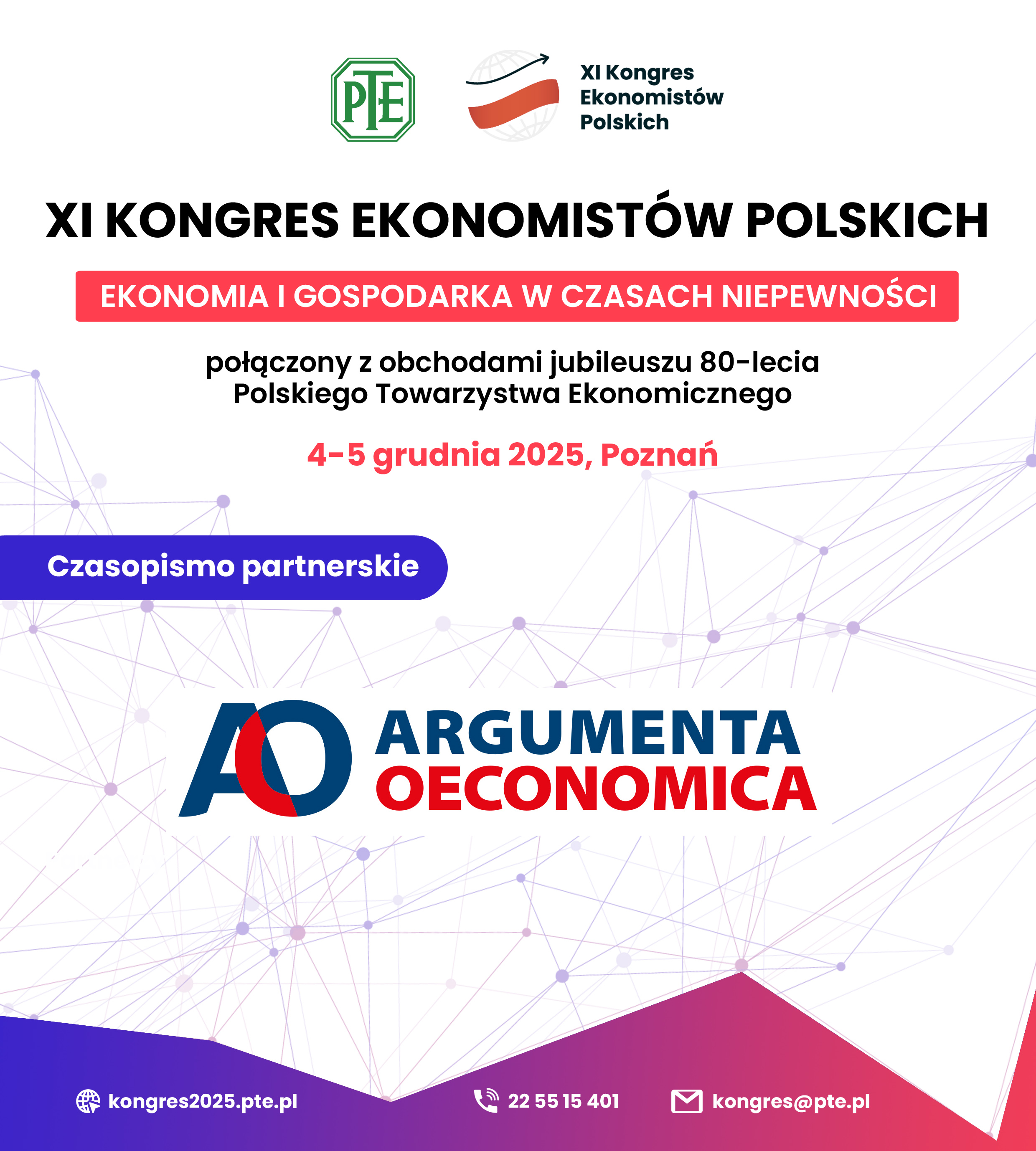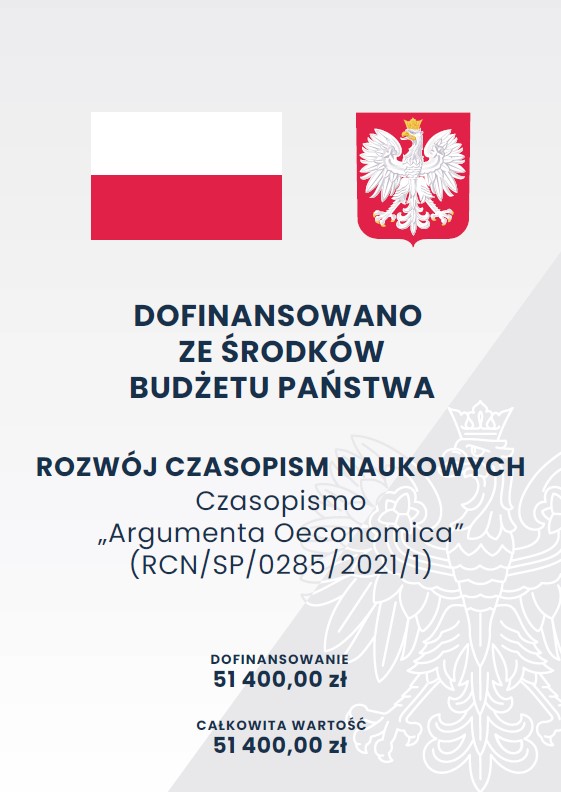Taxonomic analysis of photovoltaic technology diffusion processesin European countries
DOI:
https://doi.org/10.15611/aoe.2025.2.02Keywords:
renewable energy sources, photovoltaics, Bass model, learning curves, Ward’s methodAbstract
Aim: The aim of the article was to compare the processes of diffusion of innovations in photovoltaic technologies in European countries.
Methodology: The study used the Bass model, and on the basis of individual estimates of the parameters of this model for each of the compared countries, their taxonomic analysis was carried out.
Results: The innovators in the field of photovoltaic technologies turned out to be countries with high GDP and elevated expenditure on research and development, as well as countries whose favourable geographical location ensures a sufficiently large number of sunny days per year. This is followed, in turn, by countries with limited solar energy market potential located mainly in Central and Eastern Europe and some Scandinavian countries.
Implications and recommendations: The results presented in the article may support decision-makers in creating an appropriate system for the synchronisation and coordination of policies and activities aimed at creating an electricity system with a high share of renewable energy sources. Comparative studies of the diffusion of solar technologies are also important from the point of view of assessing the effectiveness of actions aimed at creating zero-emission economies and possible adjustments to the European Green Deal.
Originality/value: The article presents an original comparative analysis of the diffusion profiles of innovations in photovoltaics in European countries, thus the research results fill the research gap in this area.
Downloads
References
Agyekum, E. B., Kumar, N. M., Mehmood, U., Panjwani, M. K., Alhelou, H. H., Adebayo, T. S., & Al-Hinai, A. (2021). Decarbonize Russia − A best–worst method approach for assessing the renewable energy potentials, opportunities and challenges. Energy Reports, 7, 4498-4515.
Alharbi, F. H., & Kais, S. (2015). Theoretical limits of photovoltaics efficiency and possible improvements by intuitive approaches learned from photosynthesis and quantum coherence. Renewable and Sustainable Energy Reviews, 43, 1073-1089.
Allouhi, A., Rehman, S., Buker, M. S., & Said, Z. (2022). Up-to-date literature review on solar PV systems: Technology progress, market status and R&D. Journal of Cleaner Production, 362, 1-19.
Almeida, D. V., Kolinjivadi, V., Ferrando, T., Roy, B., Herrera, H., Gonçalves, M. V., & Van Hecken, G. (2023). The “greening” of empire: The European green deal as the EU first agenda. Political Geography, 105, 1-16.
Aponte, F. R., Wiebe, K. S., & Luttikhuis, N. (2023). The role of sustainability characteristics in the diffusion of renewable energy technologies. Sustainable Energy Technologies and Assessments, 57, 1-12.
Bass, F. M. (1969). A new product growth for model consumer durables. Management Science, 15(5), 215-227.
Bass, F. M. (2004). A new product growth for model consumer durables. Management Science, 50(12), 1825-1832.
Bessi, A., Guidolin, M., & Manfredi, P. (2024). Diffusion of solar PV energy in Italy: Can large-scale PV installations trigger the next growth phase? Energies, 17(3), 1-23.
Cong, R. G. (2013). An optimization model for renewable energy generation and its application in China: A perspective of maximum utilization. Renewable and Sustainable Energy Reviews, 17, 94-103.
Dan, H., & Simon, L. S. (1983). Advertising and the diffusion of new products. Marketing Science, 2(1), 1-17.
Da Silva, H. B., Uturbey, W., & Lopes, B. M. (2020). Market diffusion of household PV systems: Insights using the Bass model and solar water heaters market data. Energy for Sustainable Development, 55, 210-220.
de La Tour, A., Glachant, M., & Ménière, Y. (2013). Predicting the costs of photovoltaic solar modules in 2020 using experience curve models. Energy, 62(C), 341-348.
Dooley, K., & Kartha, S. (2018). Land-based negative emissions: Risks for climate mitigation and impacts on sustainable development. International Environmental Agreements: Politics, Law and Economics, 18, 79-98.
Elshurafa, A. M., Albardi, S. R., Bigerna, S., & Bollino, C. A. (2018). Estimating the learning curve of solar PV balance–of–system for over 20 countries: Implications and policy recommendations. Journal of Cleaner Production, 196, 122-134.
Guidolin, M. (2023). Innovation Diffusion Models: Theory and Practice, Wiley.
Grubb, M. et al. (2021). The new economics of innovation and transition: evaluating opportunities and risks. Economics of Energy Innovation and System Transition, University of Exeter, the Report, https://eeist.co.uk/download/557/
Hansen, J. P., Narbel, P. A., & Aksnes, D. L. (2017). Limits to growth in the renewable energy sector. Renewable and Sustainable Energy Reviews, 70, 769-774.
Harris, T. M., Devkota, J. P., Khanna, V., Eranki, P. L., & Landis, A. E. (2018). Logistic growth curve modeling of US energy production and consumption. Renewable and Sustainable Energy Reviews, 96(C), 46-57.
Hong, S., Chung, Y., & Woo, C. (2015). Scenario analysis for estimating the learning rate of photovoltaic power generation based on learning curve theory in South Korea. Energy, 79, 80-89.
Lindman, Å., & Söderholm, P. (2016). Wind energy and green economy in Europe: Measuring policy-induced innovation using patent data. Applied Energy, 179(C), 1351-1359.
Markard, J., Geels, F. W., & Raven, R. (2020). Challenges in the acceleration of sustainability transitions. Environmental Research Letters, 15(8), 1-6.
Meade, N., & Islam, T. (2006). Modelling and forecasting the diffusion of innovation – A 25-year review. International Journal of Forecasting, 22(3), 519-545.
Nijsse, F. J., Mercure, J. F., Ameli, N., Larosa, F., Kothari, S., Rickman, J., Vercoulen, P., & Pollitt, H. (2023). The momentum of the solar energy transition. Nature Communications, 14, 1-10.
Panda, A., Dauda, A. K., Chua, H., Tan, R. R., & Aviso, K. B. (2023). Recent advances in the integration of renewable energy sources and storage facilities with hybrid power systems. Cleaner Engineering and Technology, 12, 1-17.
Radomes Jr., A. A., & Arango, S. (2015). Renewable energy technology diffusion: An analysis of photovoltaic-system support schemes in Medellin. Journal of Cleaner Production, 92, 152-161.
Rogers, E. M. (1983). Diffusion of Innovations. 3rd edition. Free Press.
Sikora, A. (2021). European Green Deal – legal and financial challenges of the climate change. ERA Forum, 21, 681-697.
Simpson, G., & Clifton, J. (2017). Testing Diffusion of Innovations Theory with data: Financial incentives, early adopters, and distributed solar energy in Australia. Energy Research & Social Science, 29, 12-22.
Simson, K., Jørgensen, D. J., Garribba, M., Wörsdörfer, M., & Baldwin, M. (2024). State of the energy union report 2024. Directorate-General for Energy, European Commission, https://energy.ec.europa.eu/publications/state-energy-union-report-2024-country-fiches_en
Skoczkowski, T., Bielecki, S., & Wojtyńska, J. (2019). Long-term projection of renewable energy technology diffusion. Energies, 12(22), 1-24.
Wardal, W. J., Mazur, K., Barwicki, J., & Tseyko, M. (2024). Fundamental barriers to green energy production in selected EU countries. Energies, 17(15), 3664.
Zhang, X., Li, H., Liu, Q., & Tan, X. (2020). A study on the technology diffusion of China’s solar photovoltaic based on Bass and generalized Bass model. IOP Conference Series: Earth and Environmental Science, 571, 012016. https://doi.org/10.1088/1755-1315/571/1/012016
Downloads
Published
License
Copyright (c) 2025 Marcin Salamaga

This work is licensed under a Creative Commons Attribution-ShareAlike 4.0 International License.
Accepted 2025-01-24
Published 2025-08-01








